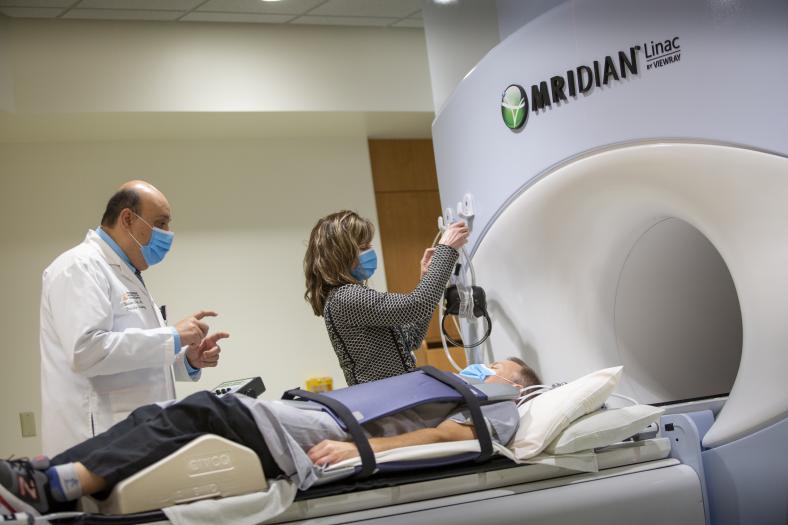What is magnetic resonance imaging-guided radiation therapy?
We use magnetic resonance imaging (MRI)-guided radiation therapy to provide real time images of your internal organs during treatment. Using MRI helps us to:
- Increase the accuracy of beams directed at the target site
- Reduce the risk of radiation exposure to your healthy tissue
Why am I having MRI-guided radiation therapy?
You may have a tumor in the abdomen, chest, or pelvis, where healthy organs can be very close to the radiation target. Even when you’re at rest, your heartbeat and breathing can affect the tumor location. Weight loss and the effect of other treatments can also affect a tumor’s location. We can better visualize the tumor and nearby tissue using MRI-guided radiation therapy. It allows us to adapt your treatment in real time.
What type of technology does MRI-guided radiation therapy use?
We use the ViewRay MRIdian technology. It combines diagnostic-quality MRI with a linear accelerator to produce therapeutic radiation beams. Worldwide, fewer than 50 hospitals have this cutting-edge technology. Our MRIdian in Lebanon is one of only two in New England.
Being treated with MRIdian is similar to having a diagnostic MRI but a bit quieter. We have noise-canceling headphones and heated blankets to help make you more comfortable. There is also a microphone that allows you to speak to us throughout your treatment. You may also receive medication before your treatment, if needed, to make the enclosed space of the MRI more tolerable. Each MRI-guided radiation therapy session typically takes longer than other treatment options.
What conditions are treated using MRI-guided radiation therapy?
We use this therapy to treat tumors in soft tissues like the pancreas or lungs. In these areas, we need precise imaging of the tumor contours and its proximity to nearby organs. MRI-guided radiation is especially valuable for monitoring parts of your body that might have unpredictable motion during treatment, such as some parts of your lungs and digestive tract. We also use this technology for some breast, head and neck, and prostate cancers.
We sometimes combine MRI-guided radiation therapy with intensity-modulated radiation therapy and stereotactic treatments that use very precise, high doses of radiation. We can also combine this technology with respiration-gated treatment.
Are there groups of patients who can’t have MRI-guided radiation therapy?
Due to the powerful magnets used in MRI-guided radiation therapy, this treatment is only an option if you do not have any metal in your body. We will use different a technology for your treatment if you have any of the following embedded or implanted in your body:
- Bullets
- Shrapnel
- Medical devices with metal components such as:
- Aneurysm clips
- Cochlear implants
- Dental fillings
- Pacemaker
